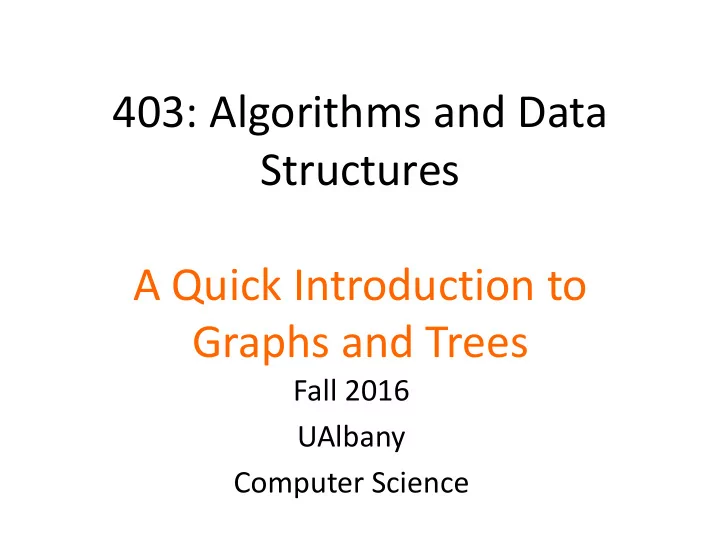

403: Algorithms and Data Structures A Quick Introduction to Graphs and Trees Fall 2016 UAlbany Computer Science
Graphs • A graph G(V,E) consists of – Set of nodes (vertices) V – Set of edges E connecting nodes • Graphs are extremely useful in modeling problems • Directed graphs represent binary relations in a set (the nodes). Undirected: symmetric binary relation self loop 1 2 1 2 5 5 3 4 3 4 (Undirected) graph Directed graph (Digraph)
Undirected graphs (terminology) 1 2 5 3 4 • The edge between 1 and 2 is denoted as (1,2) – 1 is adjacent to 2 – (1,2) is incident to 1 and 2 • Degree = # incident edges – E.g. degree of 2 is 4 • Path of length k from v 0 to v k – Sequence of k+1 nodes < v 0 , v 1 ,…, v k >, such that every consecutive pair (v i ,v i+1 ) is an edge in E – e.g. <1,2,4,5> is a path of length 3
Undirected graphs (terminology) 1 2 5 3 4 • G(V,E) is connected if there is a path between any pair of nodes • Cycle is a path that begins and ends at the same node – E.g. <3,2,4,3> • A graph without cycles is acyclic
Directed graphs (terminology) 1 2 5 3 4 • Edges are directed, so if (u,v) is an edge it is not necessary that (v,u) is also an edge • Outdegree = # edges leaving a vertex – E.g. outdegree of 2 is 3 (Why?) • Indegree = # edges coming into a vertex – E.g. indegree of 3 is 0
Directed graphs (terminology) 1 2 5 3 4 • Directed path of length k from v 0 to v k – Note that if there is a path from v 0 to v k this does not imply that there is a path from v k to v 0 • Directed cycle • Strongly connected digraph: there us a path between every pair of distinct vertices
Useful properties • For a undirected graph ∑ = 2 | E | deg( v ) v ∈ V • In a directed graph ∑ ∑ = | E | = in deg( v ) out deg( v ) v ∈ V v ∈ V
Special Classes of Graphs • Complete graph (a.k.a. clique) – edges between every pair of nodes – If |V|=n, then |E|=n(n-1)/2 • What is the rate of growth of |E|? • Trees – connected and acyclic – Rooted tree (one of the nodes is designated a root)
Rooted trees Root 1 depth 0 • 2,3 are children of 1 depth 1 3 2 • 8 is a descendant of 1 8 6 7 depth 2 5 4 • 3,1 are ancestors of 8 depth 3 9 • 2 and all its descendants form a subtree rooted at 2 • 4,5,9 are leaves: nodes with no children • Internal nodes: one or more children (e.g. 3,6) • Node height: path length to the furthest leaf • Tree height : height of the root
Facts about trees • A unique path connects any pair of nodes • If |V|=n, then |E|=n-1 – What is the rate of growth of |E|? • Deleting any edge disconnects the tree • Adding any edge results in a cycle
Binary Tree 1 • Def: each node has at most 2 children 3 2 • Left/Right subtree : 6 7 5 4 – rooted in the left/right child 8 • Complete binary tree (CBT) 1 – Each leaf has the same depth 1 – Each internal node has two children • # internal nodes in a CBT of height h is 2 h -1 3 2 1 • # leaves in a CBT: 2 h • Hence height of a CBT with n leaves is log 2 n 3 2 6 7 5 4
Generalization to k-ary tree • Each node has at most k children • If complete: – No. of internal nodes: k n -1/(k-1) – No. of leaves: k n – If we have n leaves height=log k n
Announcements • Read through Chapter 3 • HW1 solutions available on BB
Recommend
More recommend